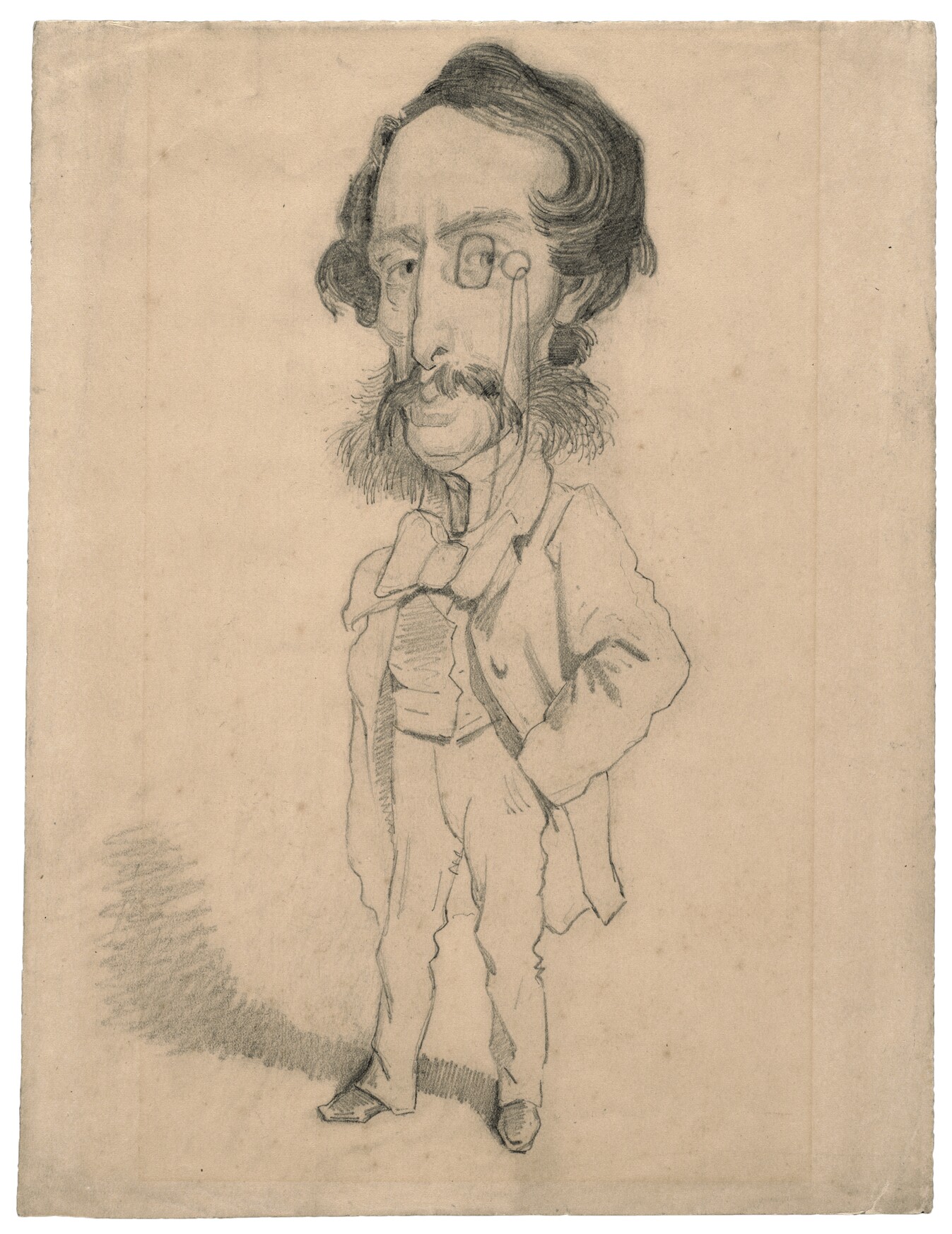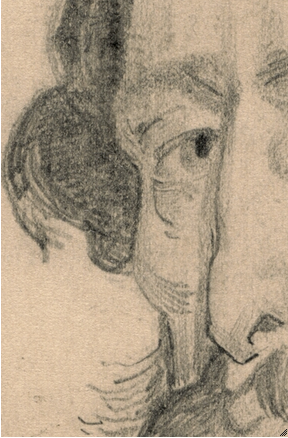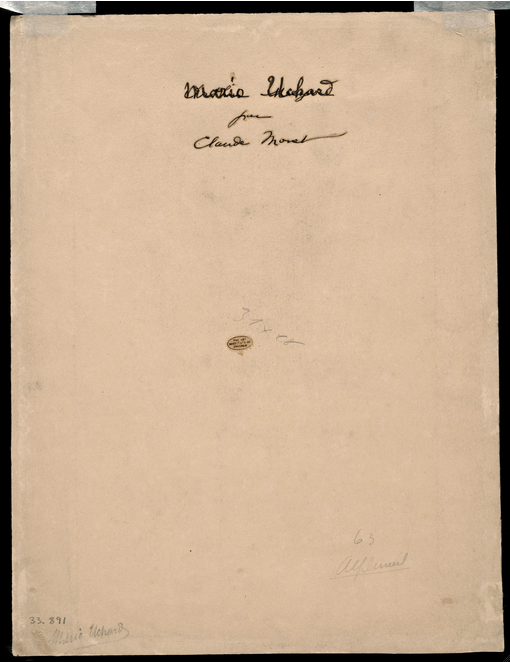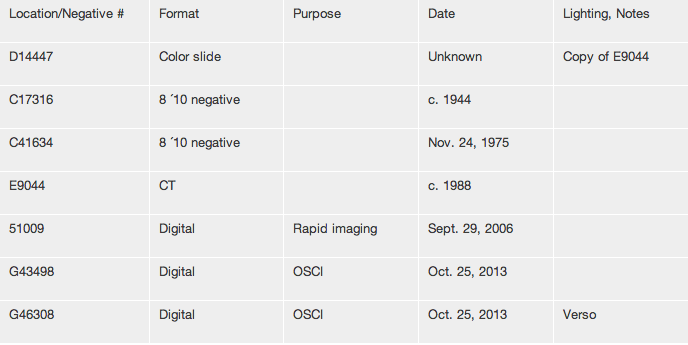Technical Report
Technical Summary
Claude Monet’s Mario Uchard was drawn in [glossary:graphite] on tan [glossary:wove] paper. The artist used fine graphite lines to establish the general form and define facial details. Broad passages of graphite were applied to create the hair, and light parallel strokes were drawn to render the shading in the figure. Some areas captured the fine texture of the wove paper; this is most noticeable in the crook of the proper left arm (fig. 5.1). Touches of erasure sharpen highlights in the face, particularly along the left side, accentuating the wrinkles below the eye, and along the nose (fig. 5.2). Added modeling in the face was created with a [glossary:stump].
Media and Support
Support Characteristics
Primary paper type
Tan, medium-thick, smooth wove paper.
Furnish
Uniform, without visible inclusions or colored fibers.
Formation
Even, machine made.
Other characteristics
All edges of the sheet exhibit some degree of irregularity; the top and right edges appear to be edge torn rather than cut.
Dimensions
320 × 245 mm
Preparatory Layers
No artistic surface alterations or coatings are visible in normal conditions or under magnification. There is a light-yellow visible-light [glossary:fluorescence] under [glossary:UV] illumination that is characteristic of a light gelatin surface [glossary:sizing].
Media Characteristics
Graphite was used throughout. Fine lines establish the general form and define facial details, and broad passages, lightly drawn, create the hair and shadows in the figure. Areas of shading pick up the fine texture of the wove paper.
Touches of erasure were used to sharpen highlights in the face, particularly along the left side, to accentuate the wrinkles below the eye and along the nose. Further modeling in the face was created with a stump.
There is no drawing on the verso.
Compositional Development
No revisions or changes are visible in the composition in normal conditions or under magnification. Some lines have been reinforced with a second stroke in the same red chalk.
Surface Treatment
No fixatives or coatings are visible in normal conditions, under UV illumination, or under magnification.
Condition History
The drawing is in good condition overall. The sheet is slightly discolored, particularly within the image area and corresponding to the opening of a former window mat. In addition, there is faint mat burn within the image area. Faint foxing spots are visible around the perimeter on the recto. The paper is slightly worn along the edges, and there is a diagonal crease and associated partial breaks across the bottom right corner.
Dark-brown ink inscriptions on the verso have formed light-brown halos along the ink lines. It is unclear whether localized degradation of the paper support, slight migration of the ink, or fixing of the ink caused the halos.
Kimberly Nichols
Selected References
Hugh Edwards, “The Caricatures of Claude Monet,” Bulletin of the Art Institute of Chicago 37, 1 (Jan. 1943), p. 71.
John Rewald, The History of Impressionism (Museum of Modern Art, New York, 1946), p. 35 (ill.).
Raymond Cogniat, Claude Monet (Flammarion, 1956), pl. 3.
Katharine Kuh and W. van der Rohe, “Homage to Claude Monet,” Art Institute of Chicago Quarterly 51, 2 (Apr. 1, 1957), p. 27.
William C. Seitz, Claude Monet (Abrams, 1960), pp. 13; 50, fig 64.
Yvon Taillandier, Monet (Flammarion, 1963), p. 7 (ill.).
Charles Merrill Mount, Monet, a Biography (Simon & Schuster, 1966), pp. 33, 396.
Phoebe Pool, Impressionism (Praeger, 1969), p. 64, fig. 44.
Maria and Godfrey Blunden, Impressionists and Impressionism, trans. James Emmons (Skira, 1970), p. 38 (ill.).
Hideji Takashima, Manet, Monet, Seurat (Holp Shuppan, 1970), chap. 1 (ill.).
Daniel Wildenstein, Claude Monet (Fratelli Fabbri, 1971), p. 90, no. 37 (ill.).
Daniel Wildenstein, Claude Monet: Biographie et catalogue raisonné, vol. 1 (Bibliothèque des Arts, 1974), p. 5.
John Rewald, History of Impressionism (Museum of Modern Art, New York, 1973), p. 39 (ill.).
Toshiaki Minemura, Monet (Shinchsha, 1974), p. 86 (ill.).
Rodolphe Walter, “Claude Monet as a Caricaturist: A Clandestine Apprenticeship,” trans. Eric Young, Apollo 103 (June 1976), pp. 489; 492.
Harold Joachim and Sandra Haller Olsen, French Drawings and Sketchbooks of the Nineteenth Century, vol. 2 (University of Chicago Press, 1979), pp. 70–71, no. 4B3.
William C. Seitz, Monet: 25 Masterworks (Abrams, 1982), p. 10 (ill.).
Douglas Skeggs, River of Light: Monet’s Impressions of the Seine (Gollancz, 1987), pp. 15 (ill.); 150
Denis Rouart, Monet (Nathan, 1990), p. 16 (ill.).
Daniel Wildenstein, Claude Monet: Catalogue raisonné, vol. 5, Supplément aux peintures: Dessins; Pastels; Index (Wildenstein Institute, 1991), p. 147, cat. D499 (ill.).
Jacques-Sylvain Klein, La Normandie: Berceau de l’impressionisme 1820–1900 (Ouest-France, 1996), p. 66.
Carla Rachman, Monet (Phaidon, 1997), p. 18 (ill. in reverse).
Birgit Zeidler, Claude Monet: Life and Work (Könemann, 2000), p. 10 (ill. in reverse).
Other Documentation
Inscriptions and Distinguishing Marks
Verso
Inscription
Location: center top
Method: brown ink, in a different hand
Content: [Arthur Neyer?] for Claude Monet (fig. 5.3)
Inscription
Location: on top of inscription Arthur, center top
Method: brown ink, in a different hand
Content: Mario Uchard (fig. 5.3)
Stamp
Location: center
Method: brown ink
Content: The Art / Institute of / Chicago
Mark
Location: center
Method: graphite
Content: 37 × 28
Mark
Location: lower left
Method: graphite
Content: 33.891
Mark
Location: lower left
Method: graphite
Content: Mario Uchard
Mark
Location: lower right
Method: graphite
Content: 63 [Alflriuerl?]
Examination Conditions and Technical Analysis
Raking Visible Light
Paper [glossary:support] characteristics identified.
Transmitted Visible Light
Paper mold characteristics identified.
Ultraviolet-Induced Visible Fluorescence (365 nm)
Light surface [glossary:size] detected overall.
Binocular Microscopy (80–100×)
Media identified.
Image Inventory
The image inventory compiles records of all known images of the artwork on file in the Imaging Department and in the conservation and curatorial files in the Department of Prints and Drawings at the Art Institute of Chicago (fig. 5.4).




